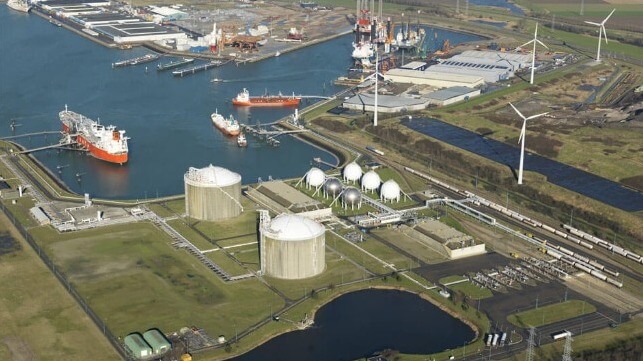Cepsa to Ship Hydrogen to Rotterdam as Port Supports Energy Transition

The Port of Rotterdam and Spanish energy company Cepsa have agreed to develop a green energy corridor to supply Spanish hydrogen transported to the Netherlands to fuel the maritime and industrial communities in Northern Europe. Using agreements such as this, the Port of Rotterdam is working along with private industry to develop the infrastructure required for future hydrogen-based energy. Rotterdam’s goal is by 2030 to build the infrastructure to supply Northwest Europe with 4.6 million tons of green hydrogen annually.
Cepsa plans to export hydrogen produced at its San Roque Energy Park near the Bay of Algeciras, through hydrogen carriers such as ammonia or methanol, to the Port of Rotterdam. Cepsa, which is the main energy company in Algeciras, has a goal to become a key player in green hydrogen production in Europe and the leader in Spain and Portugal. The trade lane is expected to be operational by 2027. Cepsa also intends to develop a similar supply chain from its La Rabida Energy Park in Huelva.
“The opportunity to build the first green hydrogen corridor in Algeciras, the leading energy port in Spain, demonstrates the unique role that Spain, and in particular Andalusia, will play in the energy transition in Europe,” said Maarten Wetselaar, CEO of Cepsa. “Spain is ideally placed to become a world leader in the production and export of green hydrogen, given its strategic location, abundant generation of renewable energies, and its robust energy infrastructures and key ports, such as Algeciras and Huelva.”
According to the companies, this supply of green fuels will help to decarbonize industry and maritime transport in the Bay of Algeciras and Rotterdam and to support the European Union’s RePower EU strategy, which seeks to guarantee Europe’s energy independence and security and stimulate the production of clean energy.
“Northwest Europe uses far more energy than it can produce in a sustainable way,” notes Allard Castelein, CEO of the Port of Rotterdam Authority. “We are therefore setting up multiple trade lanes for green hydrogen, together with exporting countries and private businesses all over the world. We expect that in 2050 some 20 million tons of hydrogen will flow through the port, of which only 2 million tons will be produced locally.
Among the private companies beginning to explore steps to build the hydrogen infrastructure at the Port of Rotterdam is Royal Vopak, operators of the large tank storage farm near the Port of Rotterdam. The company reports that in response to the growing demand for sustainable raw materials and energy, preparations are currently being made at Vopak Terminal Vlissingen for the storage of green ammonia.
Vopak said that two existing refrigerated LPG storage tanks, each with a capacity of 55,000 cbm, can be prepared for hydrogen in the form of green ammonia. Berths, pipelines, and other infrastructure are available. There is also space available for expansions and other industrial activities, such as an installation to convert the ammonia back into green hydrogen. The location will be connected to the Northwest European hydrogen network, which can be used to supply the Netherlands, Belgium, and Germany.
The final investment decision by Vopak to proceed with the conversion of its LPG capacity to ammonia storage will, among other things, be taken based on market interest.
